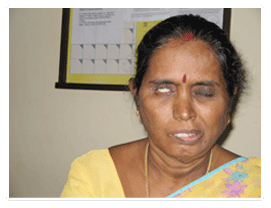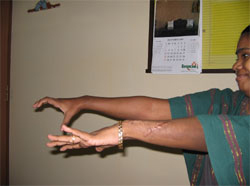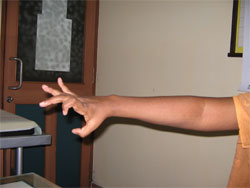A unique electrical stimulation based tool called MENTAMOVE aids recovery from paralysis and is extremely useful in recovery after stroke, multiple sclerosis, spinal cord paralysis, and facial paralysis.
- Paralysis of limbs occurs secondary to damage to the brain after a stroke, head injury or a tumor.
- A stroke is circulatory disturbance of the brain and can be due to blockage of a blood vessel, or due to rupture of a blood vessel leading to haemorrhage.
- Head injury can result in damage to the brain itself, or collection of blood inside the brain or in the coverings of the brain.
- Brain tumours can be benign or malignant and can push the brain and occupy space causing pressure of the brain or can invade and infilterate the brain
- In all these conditions after the acute incident is over, there can be weakness of the limbs of the opposite side of the body, with or without involvement of speech
- This weakness of limbs may recover if rehabilitation is started early and the brain damage is not extensive
- In most patients, there is residual weakness which is permanent or semi permanent
- This weakness is associated with stiffness of muscles called as spasticity and often associated also with pain and stiffness of the joints.
- Weakness, pain and spacticity interfere with the ability to perform ADL (Activities of Daily Living)
- Rehabilitation is the only way to improve function. There are no drugs which help. Most treatments are directed towards treating the primary cause or associated conditions like high cholesterol, hypertension, diabetes, etc and agents to reduce risk factors or prevention of a second stroke
- Rehabilitation can improve function if given appropriately and early as the brain has the capacity to adapt and recover with external stimulation – this is called neuroplasticity
- Rehabilitation options available are physiotherapy or exercises, occupational therapy or exercises aimed at improving specific functions, speech therapy for training speech, and electrical stimulation like functional electrical stimulation, biofeedback, etc
- Local injections of Botulinum toxin (Botox) can help improve spasticity, which allows better physiotherapy to be done
- In brain damage, the message from the brain to the muscle to contract is lost. If the muscle contracts, it moves the joint, which is also controlled by the extent to which the movement must occur. Most stimulation devices work at the level of the spinal cord, where an external stimulation results in a movement through a spinal reflex loop. The brain to muscle command is not redeveloped.
- Mentamove is a novel, simple, easy to use device which activates the brain to muscle communication as it uses mental imagery to enhance motor performance which develops the brain’s neuroplasticity to recruit various areas of the brain to assist recovery.
- If minimal function is available, the device is able to rapidly increase function even upto 5 years poststroke in many patients.
- In patients who recover, loss of pain and reduction of spasticity are the first symptoms to improve, hence enabling better physiotherapy as well.
- Mentamove therapy is USFDA approved and in use in several centers all over the world and is now available in India in Mumbai, Indore, Pune and Chennai.
- We, at EPICENTTRE are pleased to introduce it at Chennai
- Paralysis of limbs occurs secondary to damage to the brain after a stroke, head injury or a tumor.
- A stroke is circulatory disturbance of the brain and can be due to blockage of a blood vessel, or due to rupture of a blood vessel leading to haemorrhage.
- Head injury can result in damage to the brain itself, or collection of blood inside the brain or in the coverings of the brain.
- Brain tumours can be benign or malignant and can push the brain and occupy space causing pressure of the brain or can invade and infilterate the brain
- In all these conditions after the acute incident is over, there can be weakness of the limbs of the opposite side of the body, with or without involvement of speech
- This weakness of limbs may recover if rehabilitation is started early and the brain damage is not extensive
- In most patients, there is residual weakness which is permanent or semi permanent
- This weakness is associated with stiffness of muscles called as spasticity and often associated also with pain and stiffness of the joints.
- Weakness, pain and spacticity interfere with the ability to perform ADL (Activities of Daily Living)
- Rehabilitation is the only way to improve function. There are no drugs which help. Most treatments are directed towards treating the primary cause or associated conditions like high cholesterol, hypertension, diabetes, etc and agents to reduce risk factors or prevention of a second stroke
- Rehabilitation can improve function if given appropriately and early as the brain has the capacity to adapt and recover with external stimulation – this is called neuroplasticity
- Rehabilitation options available are physiotherapy or exercises, occupational therapy or exercises aimed at improving specific functions, speech therapy for training speech, and electrical stimulation like functional electrical stimulation, biofeedback, etc
- Local injections of Botulinum toxin (Botox) can help improve spasticity, which allows better physiotherapy to be done
- In brain damage, the message from the brain to the muscle to contract is lost. If the muscle contracts, it moves the joint, which is also controlled by the extent to which the movement must occur. Most stimulation devices work at the level of the spinal cord, where an external stimulation results in a movement through a spinal reflex loop. The brain to muscle command is not redeveloped.
- Mentamove is a novel, simple, easy to use device which activates the brain to muscle communication as it uses mental imagery to enhance motor performance which develops the brain’s neuroplasticity to recruit various areas of the brain to assist recovery.
- If minimal function is available, the device is able to rapidly increase function even upto 5 years poststroke in many patients.
- In patients who recover, loss of pain and reduction of spasticity are the first symptoms to improve, hence enabling better physiotherapy as well.
- Mentamove therapy is USFDA approved and in use in several centers all over the world and is now available in India in Mumbai, Indore, Pune and Chennai.
- We, at EPICENTTRE are pleased to introduce it at Chennai
EMG – initiated electro – stimulation is used success – fully in the rehabilitation of patients with paralyses of the extremities following central lesions such as:
- Stroke
- Brain tumor
- Craniocerebral trauma
- Brain damage in early childhood
- Multiple sclerosis
- Incomplete spinal court injury
Mentamove is based on modern knowledge and experience of neuroplasticity. The ability of the central nervous system to reorganize its function, to “recover” and to “re-learn” is amazingly great, especially if it is given the necessary support during rehabilitation.
Why Mentamove? Mentamove is effective without side effects, very user-friendly and is optimum for use in the patient’s home: self-explanatory user guidance over the display, automatic microchip controlled customization and storage of the exercise parameters, simple electrode plant.
Mentamove is used successfully in clinics and therapy practices as an additive treatment and if employed systematically it can be a direct route to improve the rehabilitant’s quality of life. Mentamove is competitive and economical. Its “primary benefit” lies in a general improvement of the patient’s state of health and contentment to be able to use social contacts again and to carry out everyday activities again.
Its “secondary benefit” should be seen in a reduction of illness costs and a decrease in medications, e.g. analgesics or antispasmodics or barbiturates. Also other aids like wheelchair, rollator or peroneus – splints are often no longer necessary. The consequences of a permanents need for nursing can also be minimized. Individual treatment with Mentamove is intended to create the optimum utilization of needs for doctors and patients.

Before Mentamove Treatment

After Mentamove Treatment
- Rise of the quality of life
- Muscle tone control (reducing spasticity)
- Initiation / re-learning and / or improving voluntary functions in the extremities eg. Improvement of literacy.
- Reducing secondary damage, e.g. pains in the shoulder joint, semi-dislocation of the shoulder joint.
- Rise of the power of concentration and motivation
- Conservation of the rest functions at Multiple sclerosis (MS)
- Reduction of the ataxia in the arms, walk and stand ataxia at MS.
Mentamove can be used effectively immediately after the event as well as years thereafter.
Mentamove should not be used by patients with heart pacemakers or during pregnancy. Please ask the doctor if risks are present!
How is Mentamove applied?
With exercising with Mentamove, neural stimulation electrodes are placed on the skin surface above the muscle responsible for the joint movement. The patient directs his full attention to carrying out a deliberate, motivating, complex movement (intention) and carries out the movement only in his imagination. He exercises in his mind.
Mentamove records the potential change generated in the target muscle and, when it reaches an individual marginal value, it converts into the intend activity. Reward for the patient => a visible movement is carried out. The voluntary motor control loop is closed via the time – linked feedback of the movement to the CNS (Central Nervous System) (efference – afference coupling and the motor learning processes are encouraged and supported.
Mentamove uses amplitude modulated medium – frequency sin- wave current. The patient fells the electrical pulse as a pleasant “soft” stimulation. The storage of data in Mentamove enables up-to date, immediate and long-term recall of the exercise parameters on the display.
Mentamove is a German product. It was developed jointly by plfR in Karlsfeld/Munich and K.I.D. – Systems GmnH in Buxtehude, a subsidiary of the Daimler-Chrysler Aerospace Airbus GmbH Company (DASA) and is manufactured to the highest quality standards of aerospace technology.
Clinical studies with Mentamove
Crisan R. & Gerner Ch.2000, the effectiveness of EMG-initiated electro stimulation in patients who had suffered a stroke more than 1 year previously. Neurological & Geriatric Rehabilitation Clinic, Rottal Foundation, Bad Briesbach. Germany.
Clinical studies of effectiveness
- Mokrusch T., et al: Statement by GESET 1999, Value of EMG-controlled electro-stimulation.
- Kraft G.H., 1992, Techniques to improve function of Arm and Hand; Chronic Hemiplegia.
- Hummelsheim H. at al: 1996, The influence of EMG – initiated electrical muscle stimulation.




